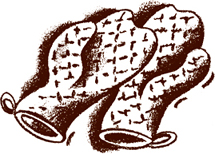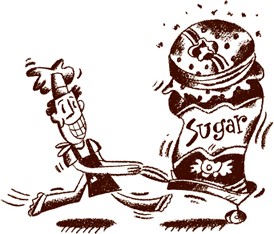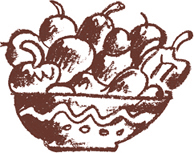
When dessert time rolls around, a lot of grill jockeys extinguish the fire. I say a good barbecue should end with a blast—preferably of flames or wood smoke. The s’mores many of us made as kids are a good starting point, but there’s more. Grilled pound cake (served with smoky whipped cream), glazed “doughnuts” (grilled doughnut peaches), and flame-roasted coconut custards are just a few of the desserts you can serve at a cutting-edge barbecue. In fact, about the only thing you can’t grill is ice cream. Or can you? In this chapter, you’ll even find a baked Hawaii (my version of baked Alaska) and a refreshing grilled nectarine smoothie. When it comes to dessert, the barbecue is just beginning.

I’ve always been fond of toasted pound cake, and the grill’s a natural for toasting. Smoke and sugar often work in mysterious and complementary ways—think of barbecue sauce and grilled chicken or crème brûlée. Here they work their magic on whipped cream. If you think regular pound cake is good, just wait until you taste it hot off the grill.

4 cups mixed berries, such as blueberries, raspberries, and strawberries
2 to 3 tablespoons sugar
2 teaspoons fresh lemon juice
1½ cups heavy (whipping) cream, well chilled
3 to 4 tablespoons confectioners’ sugar, or more to taste
1 tablespoon Laphroaig or other smoky single-malt scotch, or 1 tablespoon blended whiskey
1 to 2 drops liquid smoke (optional)
8 slices pound cake (about ¾ inch thick each)
8 sprigs fresh mint
1. Rinse the berries, removing any stems or leaves. If using strawberries, cap them and cut any large berries in half or in quarters. Place the berries in a nonreactive bowl with the sugar and lemon juice. Not more than an hour before serving, gently toss the berries with the sugar and lemon juice to mix.
2. Prepare the whipped cream: Chill the bowl of an electric mixer or a metal bowl in the freezer. When cold, add the cream and, using an electric mixer, beat until soft peaks form, 5 to 7 minutes. Add the confectioners’ sugar and scotch (or whiskey and liquid smoke) and continue beating the whipped cream until stiff peaks form, 1 to 2 minutes more. Don’t overbeat or you’ll get whiskey-flavored butter. Keep the whipped cream chilled until you are ready to serve.
3. Set up the grill for direct grilling (see page 8 for both charcoal and gas) and preheat to medium-high.
4. When ready to cook, brush and oil the grill grate. Grill the pound cake slices until toasted on both sides, 1 to 2 minutes per side. Transfer the toasted pound cake to plates and top with the sweetened berries and dollops of smoky whipped cream. Garnish each serving with a mint sprig and serve at once.
SERVES 8
Doughnut peaches burst on the food scene in the United States in the 1990s. It was love at first bite. We loved the steamrollered look of these flat peaches with their indented centers (they really do resemble doughnuts). We loved their musky sweetness and their high ratio of flesh to pit. What most of us didn’t appreciate at the time is just how well suited the flat shape of a doughnut peach is to grilling. Then again, a decade ago, most Americans didn’t realize you could grill fruit. Here, smokily grilled doughnut peaches are glazed with bourbon, butter, and brown sugar, and I doubt there’s a tastier “doughnut” in existence.

½ cup firmly packed light brown sugar
8 tablespoons (1 stick) unsalted butter
½ teaspoon ground cinnamon
¼ teaspoon ground cloves
Pinch of coarse salt (kosher or sea)
4 large or 8 small ripe doughnut peaches, stems removed
Vanilla ice cream (optional), for serving
Sprigs of fresh mint, for garnish
YOU’LL ALSO NEED:
1 cup wood chips (optional; preferably hickory), soaked for 1 hour in water to cover, then drained
1. Combine the bourbon, brown sugar, butter, cinnamon, cloves, and salt in a heavy saucepan and bring to a boil over high heat. Let the glaze simmer briskly until thick, 4 to 6 minutes. Remove the pan from the heat.
2. Rinse the peaches and pat dry.
3. Set up the grill for direct grilling (see page 8 for both charcoal and gas) and preheat to high. If using a gas grill, place all the wood chips, if using, in the smoker box or in a smoker pouch (see page 12) and preheat on high until you see smoke.
4. When ready to cook, if using a charcoal grill, toss all of the wood chips, if using, on the coals. Place the peaches on the top grate and grill until nicely browned on both sides, 2 to 4 minutes per side, basting each side with the glaze twice. Transfer the peaches to plates or a platter and top with ice cream, if desired. Spoon any remaining glaze over the peaches. Garnish with mint sprigs and serve at once, warning your guests to watch for the tiny pits.
SERVES 4
Americans have a soft spot for peaches and cream—and with good reason. There’s nothing like the contrast of a brassily acidic ripe summer peach with the lip-smacking richness of whipped cream—especially when that cream is spiced with cinnamon and spiked with rum. It will melt into fragrant puddles the moment it hits the hot fruit.

1 cup heavy (whipping) cream
3 tablespoons confectioners’ sugar, or more to taste
½ teaspoon ground cinnamon
1 tablespoon light rum
4 large ripe freestone peaches
3 tablespoons melted butter
3 tablespoons granulated sugar
8 fresh mint leaves, for garnish
1. Prepare the whipped cream: Chill the bowl of an electric mixer or a metal bowl in the freezer. When cold, add the cream and, using an electric mixer, beat until soft peaks form, 5 to 7 minutes. Add the confectioners’ sugar, cinnamon, and rum and beat briefly. Taste the whipped cream and add more sugar if necessary. Continue beating the whipped cream until stiff peaks form, 1 to 2 minutes more. Keep the whipped cream chilled until you are ready to serve.
2. Rinse the peaches and pat dry with paper towels. Cut each in half along the crease and twist the halves in opposite directions to separate them. Using a spoon, remove and discard the pit from each. Brush each peach half with some of the melted butter and sprinkle with some of the granulated sugar.
3. Set up the grill for direct grilling (see page 8 for both charcoal and gas) and preheat to high.
4. When ready to cook, brush and oil the grill grate. Place the peaches on the grill cut side down. Grill until golden brown on both sides, 2 to 4 minutes per side. Transfer the peaches to a platter or plates, arranging them cut side up, and place a dollop of the flavored whipped cream on top. Garnish each peach half with a mint leaf. Serve any remaining whipped cream on the side.
SERVES 4

Cool, creamy coconut custard—is there anything more delicious? How about a coconut custard grilled in a coconut shell? I often use coconut shells as serving bowls for desserts, but in this recipe, the custard is actually grilled in coconut shells. These must have functioned as pots in early culinary history, I reasoned, so why not use them as baking dishes? Sure, the shell might burn, but the crisp coconut flesh ought to keep the custard safe from the flames. Not only did the idea work, the resulting dessert, with its golden custard and flame-darkened shell, is a guaranteed showstopper. There’s another advantage to cooking a custard in this manner: As the shell roasts, it imparts a delicate smoke flavor to the custard.
2 ripe (brown-shelled) coconuts
2 large eggs
Yolks of 4 large eggs
4 tablespoons sugar, or more to taste
¾ cup unsweetened coconut milk
¾ cup heavy (whipping) cream
1 tablespoon light rum
1 teaspoon vanilla extract
1 teaspoon finely grated lemon zest
½ teaspoon ground cinnamon
1. Crack each coconut in half around its circumference. The easiest way to do this is to tap the shell repeatedly with the dull spine (not the sharp edge) of a cleaver along an imaginary line going around the middle. Work over a bowl with a strainer to collect the coconut water. After about 10 gentle taps, the shell will begin to crack. Continue tapping the shell and the crack will get larger. You will be able to drain the coconut water into the bowl and pull the halves of the coconut apart easily. Save the coconut water to use for making drinks.
2. Cut aluminum foil into 4 strips, each 12 by 3 inches. Crumple the foil strips and shape them into 4 rings, each about 2 inches in diameter. Set a coconut half upright on one of each.
3. Place the eggs, yolks, and sugar in a mixing bowl and whisk just to combine. Shake the coconut milk well before opening the can. Whisk the coconut milk, cream, rum, vanilla, lemon zest, and cinnamon into the egg mixture. Taste for seasoning; if a sweeter custard is desired, add sugar. Fill each coconut half with custard mixture.
4. Set up the grill for indirect grilling (see page 9 for both charcoal and gas) and preheat to medium. When ready to cook, arrange the filled coconut halves on their aluminum foil rings in the center of the hot grate, away from the heat. Cover the grill and cook the custards until the tops are golden and the custard is set, 20 to 30 minutes. The shells will brown at their cut edges. To test for doneness, shake a shell with tongs: The custard will wiggle, not ripple, when cooked through. Another way to test for doneness is to insert a bamboo skewer or toothpick into a custard. It will come out clean when the custard is cooked.
5. Remove the coconut halves and aluminum foil rings from the grill, using tongs and a spatula, and set on a baking sheet or wire rack on a heatproof surface. (Use the tongs to steady a coconut half as you slide the spatula under the aluminum foil ring.) Let cool to room temperature, then refrigerate until serving.
6. Serve the coconut custards in the shells. If you’re feeling fancy, put the shells in shallow bowls filled with crushed ice. Otherwise, serve them on the aluminum foil rings to keep them upright.
SERVES 4

VARIATION: You can use the direct method to grill the custards. Set up the grill for direct grilling (see page 9 for both charcoal and gas) and preheat to medium. When ready to cook, arrange the filled coconut halves on their aluminum foil rings on the hot grate directly over the fire. Grill until the custards are cooked, 15 to 20 minutes. The shells may darken, which is fine. Let the custards cool, then refrigerate until serving.
When I was growing up, baked Alaska was a restaurant theatric reserved for special occasions, like your birthday or graduation from junior high school. Festooned with rococo swirls of meringue, it was ceremoniously flambéed at the table-side, and you weren’t really sure if you should eat it or just look at it. Of course, nothing would seem less suited for grilling than a dish in which the main ingredient is ice cream. But by using the indirect grilling method, you can turn out a dessert that’s icy on the inside and smoking on the outside—just as tradition dictates. So what’s with the baked Hawaii? It’s my update of the American classic, using fresh pineapple instead of cake.
1 ripe pineapple with leaves attached
1 pint your favorite-flavor ice cream or frozen yogurt (I like cherry), slightly softened
2 tablespoons 151-proof or light rum, plus ¼ cup for flambéing (optional)
FOR THE MERINGUE:
Whites of 4 large eggs, at room temperature
½ teaspoon cream of tartar
¾ cup confectioners’ or superfine sugar (see Note)
1 teaspoon vanilla extract
1. Lay the pineapple on its side with the leafy crown away from you (don’t cut off the leaves; they’re part of the presentation). Using a long, sharp knife, cut the pineapple in half lengthwise, starting at the bottom and cutting through the leaves as well as the fruit. Working on one half of the pineapple at a time, remove the core by making 2 cuts into the flesh, angling the knife blade down along the core to cut out a V-shape wedge the length of the fruit. Repeat with the other half. Discard the core, then remove the flesh from the pineapple, cutting within ½ inch of the rind and following its contours (a grapefruit knife works well for this). It is easier to cut out the flesh if you make a few cuts that run the length of the fruit but be careful not to pierce the rind.
2. Cut the pineapple flesh into ¾-inch pieces and transfer to a mixing bowl. Scoop in the ice cream, add 2 tablespoons rum, if using, and stir to combine. Pack the pineapple mixture back into the pineapple shells, mounding it up slightly. Wrap each pineapple half in plastic wrap and place in the freezer.
3. Make the meringue: Place the egg whites and cream of tartar in the bowl of an electric mixer. Start beating at low speed until frothy. Gradually increase the speed to medium, then medium-high, and beat until the whites stiffen to soft peaks (they’ll look like soft ice cream), about 8 minutes. Increase the mixer speed to high and beat in the sugar, followed by the vanilla. Continue beating until the mixture is glossy and firm, but not dry, 1 to 2 minutes. Do not overbeat or the meringue will collapse.
4. Transfer the meringue to a pastry bag fitted with a large star tip. Remove the pineapple halves from the freezer. The filling should be frozen 3 hard. Pipe decorative swirls of meringue over the ice cream mixture, covering it completely and extending just a little over its edge. If you don’t have a piping bag, spread the meringue over the fruit with a spatula or a spoon. Place the meringue-covered pineapple halves in the freezer, uncovered, for at least 15 minutes to firm up the ice cream. The meringue-covered pineapple can be frozen for up to a day.
5. Set up the grill for indirect grilling (see page 9 for both charcoal and gas) and preheat to high.
6. When ready to cook, place the pineapple halves on the hot grate, away from the heat. Cover the grill and cook until the meringue is handsomely browned, 3 to 6 minutes. Transfer the baked Hawaii to a heatproof platter. If you choose to flambé the dessert, warm ¼ cup of rum in a small saucepan but do not let it boil. Remove the rum from the heat and, working away from anything flammable and making sure that your sleeves are rolled up and your hair is tied back, ignite it with a long kitchen match. Pour the flaming rum over the baked Hawaii. Serve at once.
SERVES 8
NOTE: I’ve had some trouble finding superfine sugar, but if you can find it, it dissolves more quickly. If it’s not with the baking supplies, look in the section of the supermarket that has the cocktail mixes.
How about a refreshing summer smoothie made with, you guessed it, grilled fruit? The accents of smoke and fire add depth to this popular summer libation. The resulting smoothie is rich enough to double as a light dessert. In this recipe, the smoothie is flavored with nectarines, but you could certainly use grilled peaches, apricots, bananas, or pineapple instead.

2 large or 3 medium-size very ripe nectarines
¾ cup sugar
1 tablespoon ground cinnamon, or more to taste and for garnishing the smoothies
1½ cups frozen vanilla yogurt or ice cream
2 cups soy milk (see Note)
2 tablespoons maple syrup, or more to taste
1. Rinse the nectarines and pat dry with paper towels. Cut each nectarine in half along the crease and twist the halves in opposite directions to separate them. Cut each nectarine half in half and lift off and discard the pit.
2. Set up the grill for direct grilling (see page 8 for both charcoal and gas) and preheat to high.
3. When ready to cook, brush and oil the grill grate. Combine the sugar and 1 tablespoon of cinnamon in a shallow bowl and stir to mix. Dip each nectarine quarter in the sugar mixture, shaking off the excess. Save any extra sugar for future grilling. Arrange the nectarines on the hot grate and grill until nicely browned on all sides, 2 to 3 minutes per side (6 to 9 minutes in all). Transfer the nectarines to a platter and let cool. Cut one quarter lengthwise into 2 thin wedges (skinning the fruit is optional). Cut the remaining nectarine quarters into large dice. The grilled nectarines can be refrigerated in a covered bowl for up to 3 days.
4. Place the diced nectarines, frozen yogurt, soy milk, and maple syrup in a blender, and working in batches if necessary, blend until smooth. Taste for seasoning, adding maple syrup and/or cinnamon to taste. Pour the smoothies into 2 tall glasses and garnish each with a nectarine wedge (press it over the edge of the glass). Lightly dust the smoothies with cinnamon and serve at once.
SERVES 2
NOTE: I’ve been drinking a lot of soy milk lately. I love its nutty flavor, and it’s healthy as all get out. Of course, you could always substitute whole or skim cow’s milk in the smoothies.